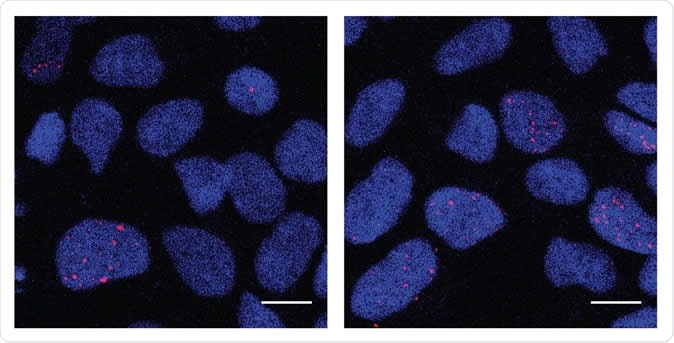Salk Institute researchers have now found a pattern of DNA damage that is unique to brain cells derived from individuals with a single form of autism spectrum disorder (ASD) called macrocephalic ASD. The study, published in the journal Cell Stem Cell in January 2020, may offer an explanation about the developmental misstep that caused this disease.
Most genetic disorders arise because of cell division or replication, which involves the prior duplication of the DNA strand. The cell is set up to accomplish this demanding process with great accuracy, because a mistake in the DNA strand can have potentially disastrous effects on the organism’s physiology. When errors occur, or are induced, in the process of DNA replication, threatening the proper completion of the process, the cell senses a replication-linked danger to the integrity of the genome which is slowing or even stalling the process of DNA synthesis and replication fork progression. This is called replication stress, and provokes an appropriate cellular response, including DNA repair.
The occurrence of errors is common during embryonic life, when new cells, tissues and organs are forming at high speed. The vast majority of these errors are repaired spontaneously and well in time. Many or most such errors occur when the rate of cell division is speeded up or arrested either due to environmental stress or due to genetic defects.

Cells that will eventually become neurons (neural progenitor cells) derived from individuals with autism spectrum disorder, shown in the right panel, exhibit increased DNA damage detected by ?H2AX, shown in the red stain, compared to those derived from healthy individuals (left panel). Image Credit: Salk Institute
ASD and stem cells
ASD is a disorder of communication, behavior and social interaction that is diagnosed in approximately 1 of 60 children in the USA, according to the statistics released by the Centers for Disease Control and Prevention. Not much research has been done into the root causes or therapies for the disease.
It was in 2016 that the present team of researchers first found a higher rate of growth in stem cells found in the brains of people with macrocephalic ASD compared to those derived from healthy individuals. Stem cells are the source of more specialized or differentiated cells and tissues in the body, including nerve cells. The increased growth rate could be part of the reason for the macrocephaly, or abnormally large head size, in this group of people – the researchers found that the stem cells were multiplying excessively during the period of brain development.
The study
In the present study, they delved deeper into these stem cells found in the brain, also called neural precursor cells (NPCs). Their aim was to see if the abnormally high rate of proliferation caused more errors to occur and pile up during DNA replication.
They used skin cells collected from people with ASD and macrocephaly, and from people without ASD. They then reprogrammed the cell’s biological clock to induce it to turn back into a stem cell that could give rise to nerve cells – the NPC.
These cells were now treated with a chemical that stimulates cell replication, and thus puts stress on the DNA replication. They first used stem cells from the non-ASD group to identify the most vulnerable segments of DNA, where the most damage was likely to build up. They then repeated the process with autistic individuals.
The findings
The findings were remarkable. There were 36 genes that showed damage in NPCs obtained from people with ASD as well as from neurotypical (without ASD) individuals. However, NPCs from the first group showed much higher DNA damage levels. Secondly, 26/36 genes had already been found to be associated with ASD in other studies.
Study author Meiyan Wang says, “What the new results are telling us is that cells from people with macrocephalic autism not only proliferate more but naturally experience more replication stress.” The increased rate of proliferation of the NPCs is probably the reason for the macrocephaly as well as the replication stress that is a major cause of the ASD-linked mutations.
The researchers were able to detect the sites of DNA injury. However, it is not clear as to what fraction of this damage underwent repair before the subsequent differentiation of the cell, and how many cells differentiated into mature neurons carrying permanently altered DNA within their genome.
This will probably be the focus of future studies. Wang says, “We'd like to look deeper at how replication stress and DNA damage affects neuronal function in the long term and whether adult neurons arising from these stem cells have more mutations than usual.”
Journal reference:
Meiyan Wang, Pei-Chi Wei, Christina K. Lim, Iryna S. Gallina, Sara Marshall, Maria C. Marchetto, Frederick W. Alt, Fred H. Gage, Increased Neural Progenitor Proliferation in a hiPSC Model of Autism Induces Replication Stress-Associated Genome Instability, Cell Stem Cell, https://doi.org/10.1016/j.stem.2019.12.013